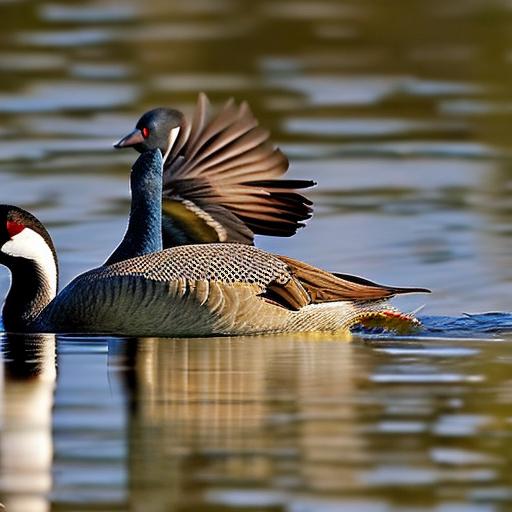Canada geese are a common sight in many parts of North America, but their increasing population has led to a variety of problems. These large birds can cause damage to property, create safety hazards, and contribute to environmental issues. It is important to find humane solutions to manage the Canada goose population and mitigate the negative impacts they can have on communities.
Key Takeaways
- Canada geese are attracted to open spaces near water and grassy areas.
- Natural deterrents like planting tall grasses and using decoys can help keep Canada geese away.
- Physical barriers like fences and netting can be effective in preventing Canada geese from accessing certain areas.
- Scare tactics like loud noises and predator decoys can be used to deter Canada geese.
- Habitat modification, such as reducing open spaces and removing food sources, can help prevent Canada geese from settling in an area.
Understanding the Behavior of Canada Geese
To effectively address the Canada goose problem, it is crucial to understand their behavior. Canada geese are migratory birds that travel long distances during certain times of the year. They have specific nesting habits, often choosing areas near water bodies to build their nests. Additionally, Canada geese are herbivores and feed on grasses, grains, and aquatic plants.
Natural Deterrents for Canada Geese
One approach to deterring Canada geese is to use natural methods that make their preferred habitats less appealing. Planting certain types of vegetation, such as tall grasses or shrubs, can create barriers that discourage geese from nesting or feeding in an area. Installing decoys, such as plastic coyotes or alligators, can also deter geese by creating the illusion of predators. Sound deterrents, such as devices that emit distress calls or predator sounds, can further discourage geese from settling in an area.
Creating Physical Barriers to Keep Canada Geese Away
Physical barriers can be effective in preventing Canada geese from accessing certain areas. Fencing can be installed around ponds or other water bodies to prevent geese from entering and causing damage. Netting can be used to cover areas where geese may try to nest or feed, making it difficult for them to access these spaces. Water deterrents, such as floating devices or motion-activated sprinklers, can also be used to discourage geese from congregating in specific areas.
The Role of Scare Tactics in Deterring Canada Geese
Scare tactics can be employed to deter Canada geese from settling in unwanted areas. Motion-activated devices, such as sprinklers or lights, can startle geese and make them feel unsafe. Predator decoys, such as plastic owls or hawks, can create the illusion of a threat and discourage geese from staying in an area. Visual deterrents, such as reflective tape or flags, can also be effective in deterring geese by creating a sense of danger.
Implementing Habitat Modification to Prevent Canada Geese

Modifying the habitat can make an area less attractive to Canada geese. Altering the landscape by removing or trimming grasses near water bodies can discourage geese from nesting or feeding. Removing food sources, such as spilled grains or grass clippings, can also reduce the appeal of an area to geese. Additionally, reducing water access by installing barriers or modifying shorelines can make it more difficult for geese to settle in an area.
Using Repellents to Keep Canada Geese at Bay
Repellents can be used to deter Canada geese from specific areas. Chemical repellents, such as methyl anthranilate, can be applied to grassy areas to make them less appealing to geese. Natural repellents, such as garlic or pepper sprays, can also be effective in deterring geese. Electronic repellents, such as ultrasonic devices or lasers, emit sounds or lights that are unpleasant to geese and discourage them from staying in an area.
The Importance of Proper Waste Management in Canada Goose Control
Proper waste management is crucial in controlling the Canada goose population. Removing food waste, such as discarded bread or other human food, can reduce the availability of food sources for geese and discourage them from congregating in certain areas. Cleaning up after picnics or outdoor events can also prevent geese from being attracted to these areas. Properly disposing of trash and keeping garbage cans securely closed can further reduce the availability of food for geese.
Seeking Professional Help for Canada Goose Management
In some cases, it may be necessary to seek professional help to manage the Canada goose population. Wildlife control companies specialize in humane methods of deterring geese and can provide effective solutions tailored to specific situations. Consulting with a veterinarian can also be beneficial, as they can provide guidance on managing geese in a way that is safe for both humans and the birds. Additionally, contacting local authorities, such as animal control or environmental agencies, can provide valuable resources and support in addressing the Canada goose problem.
Educating the Community on Canada Goose Behavior
Educating the community about Canada goose behavior is essential in promoting responsible and effective management strategies. Hosting workshops or informational sessions can provide residents with knowledge about geese and how to deter them. Distributing informational flyers or brochures can also help raise awareness and provide practical tips for preventing conflicts with geese. Encouraging responsible behavior, such as not feeding geese or properly disposing of waste, can further contribute to long-term solutions.
Long-Term Strategies for Sustained Canada Goose Control
Sustained Canada goose control requires consistent maintenance and regular monitoring. It is important to regularly assess the effectiveness of deterrent methods and make adjustments as needed. Adapting to changing circumstances, such as shifts in goose behavior or population size, is crucial in maintaining successful management strategies. By implementing long-term strategies and staying vigilant, communities can effectively manage the Canada goose population and minimize the negative impacts they can have.
In conclusion, finding humane solutions to manage the Canada goose population is crucial in mitigating the problems they can cause. Understanding their behavior, implementing natural deterrents, creating physical barriers, using scare tactics, modifying habitats, using repellents, practicing proper waste management, seeking professional help, educating the community, and implementing long-term strategies are all important steps in effectively managing Canada geese. By taking action and implementing these strategies, communities can coexist with Canada geese in a way that is safe and sustainable for both humans and the birds.
If you’re looking for effective ways to keep Canada geese away from your property, you might also be interested in learning about chicken coop interior ideas. Creating a secure and well-designed chicken coop can not only provide a safe haven for your feathered friends but also deter unwanted visitors like geese. Check out this informative article on poultrywizard.com that offers valuable insights and tips on maximizing the interior space of your chicken coop: https://poultrywizard.com/keeping-chickens/chicken-coop-interior-ideas/. Additionally, if you’re wondering where to position your chicken coop for optimal functionality and protection, this article provides helpful guidance: https://poultrywizard.com/keeping-chickens/where-to-put-chicken-coop/. Lastly, if you’re in the market for a reliable and sturdy chicken coop, consider checking out the Producers Pride Sentinel Chicken Coop, which offers excellent security features: https://poultrywizard.com/keeping-chickens/producers-pride-sentinel-chicken-coop/.
FAQs
What are Canada Geese?
Canada Geese are large water birds that are native to North America. They are known for their distinctive black heads and necks, white cheeks, and brown bodies.
Why do Canada Geese need to be kept away?
Canada Geese can cause damage to property, create health hazards, and be a nuisance to people. They can also be aggressive during nesting season.
What are some methods for keeping Canada Geese away?
Some methods for keeping Canada Geese away include using visual deterrents, such as scarecrows or reflective tape, using noise deterrents, such as loud noises or predator calls, and using physical barriers, such as fences or netting.
Are there any humane methods for keeping Canada Geese away?
Yes, there are humane methods for keeping Canada Geese away. These include using non-toxic repellents, such as grape extract or peppermint oil, and modifying the habitat to make it less attractive to geese, such as removing food sources or planting tall grasses.
Is it legal to harm Canada Geese?
No, it is not legal to harm Canada Geese without a permit. Canada Geese are protected under the Migratory Bird Treaty Act, which prohibits the killing, capturing, or harming of migratory birds without a permit.
Meet Walter, the feathered-friend fanatic of Florida! Nestled in the sunshine state, Walter struts through life with his feathered companions, clucking his way to happiness. With a coop that’s fancier than a five-star hotel, he’s the Don Juan of the chicken world. When he’s not teaching his hens to do the cha-cha, you’ll find him in a heated debate with his prized rooster, Sir Clucks-a-Lot. Walter’s poultry passion is no yolk; he’s the sunny-side-up guy you never knew you needed in your flock of friends!







